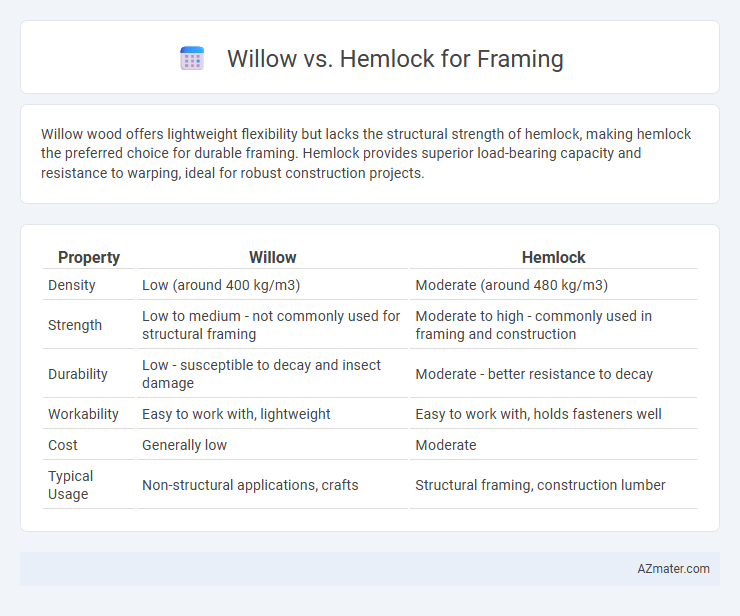Willow wood offers lightweight flexibility but lacks the structural strength of hemlock, making hemlock the preferred choice for durable framing. Hemlock provides superior load-bearing capacity and resistance to warping, ideal for robust construction projects.
Table of Comparison
| Property | Willow | Hemlock |
|---|---|---|
| Density | Low (around 400 kg/m3) | Moderate (around 480 kg/m3) |
| Strength | Low to medium - not commonly used for structural framing | Moderate to high - commonly used in framing and construction |
| Durability | Low - susceptible to decay and insect damage | Moderate - better resistance to decay |
| Workability | Easy to work with, lightweight | Easy to work with, holds fasteners well |
| Cost | Generally low | Moderate |
| Typical Usage | Non-structural applications, crafts | Structural framing, construction lumber |
Introduction to Willow and Hemlock Wood
Willow wood is lightweight, moderately soft, and known for its flexibility, making it less common but suited for specialized, low-stress framing projects. Hemlock wood is a strong, dense softwood with excellent dimensional stability and resistance to warping, widely preferred in construction framing for its durability and load-bearing capacity. Both woods vary in availability, with hemlock being more accessible and economical in North American markets compared to willow.
Botanical Overview: Willow vs Hemlock
Willow (genus Salix) features fast-growing, flexible wood prized for lightweight and durability in framing, with its fibrous structure offering moderate strength. Hemlock (Tsuga genus), a coniferous softwood, provides dense, uniform grain and excellent stability, favored for structural framing due to high load-bearing capacity. Both species present contrasting botanical traits--willow's broadleaf deciduous nature versus hemlock's evergreen conifer status--impacting their performance and suitability in construction.
Strength and Durability Comparison
Willow wood is lightweight and flexible but lacks the strength and durability required for structural framing. Hemlock, on the other hand, offers superior strength and resistance to decay, making it a more reliable choice for framing applications in construction. Builders prefer hemlock for load-bearing structures due to its higher density and longer lifespan compared to willow.
Workability and Ease of Use
Willow offers superior workability and ease of use for framing due to its lightweight and flexible nature, allowing for quicker cutting, shaping, and assembly compared to hemlock. Hemlock is denser and harder, providing greater strength but requiring more effort and specialized tools to work with effectively. The choice between willow and hemlock depends on balancing the need for lightweight handling and rapid construction versus durability and structural integrity in framing projects.
Resistance to Decay and Pests
Willow wood offers moderate resistance to decay and pests but generally requires treatment for optimal durability in framing applications. Hemlock, known for its natural resistance to decay and insects, provides better long-term performance without extensive chemical treatment. For framing purposes, hemlock is often preferred due to its superior resistance to moisture-related damage and insect infestation.
Sustainability and Environmental Impact
Willow frames offer superior sustainability due to their rapid growth cycle and high carbon sequestration potential compared to Hemlock, which grows slower and requires more intensive forestry management. Hemlock's denser wood is less renewable and often sourced from older forests, leading to greater ecological disturbance and reduced biodiversity. Choosing Willow for framing reduces environmental impact by promoting faster forest regeneration and minimizing habitat destruction associated with timber harvesting.
Cost and Availability in Construction
Willow wood is generally more affordable than hemlock, making it a cost-effective option for framing projects on a budget. Hemlock offers greater availability in North American markets due to its widespread growth, ensuring a steady supply for construction needs. Cost variations can arise from regional demand and harvesting practices, but willow's quicker growth rate often results in lower prices and faster replenishment compared to hemlock.
Aesthetic Differences in Framing
Willow framing offers a unique grain pattern and a lighter color that enhances modern and rustic design aesthetics, making it ideal for visually striking interiors. Hemlock features a more uniform texture with subtle, reddish-brown hues that provide a classic, warm appearance suited for traditional framing projects. The choice between willow and hemlock significantly impacts the visual appeal, with willow emphasizing natural uniqueness and hemlock delivering consistent, refined elegance.
Common Applications in Building Projects
Willow and Hemlock both serve distinct roles in framing for building projects, with Hemlock commonly used for structural framing due to its strength, straight grain, and resistance to splitting, making it ideal for walls, floors, and roof frameworks. Willow, although softer and less structural, is frequently employed in non-load bearing applications or decorative elements where flexibility and aesthetic appeal are valued, such as in interior paneling or lightweight partitions. Builders select Hemlock for durability and load-bearing capacity while opting for Willow in projects requiring lightweight, easily workable wood that complements other framing materials.
Conclusion: Choosing Between Willow and Hemlock for Framing
Willow offers lightweight properties and flexibility, making it suitable for smaller or decorative framing projects, while Hemlock provides superior strength and durability essential for structural framing in construction. Hemlock's resistance to warping and its consistent grain pattern ensure long-term stability, positioning it as the preferred choice for load-bearing frames. Selecting between Willow and Hemlock depends on the project's structural requirements, with Hemlock favored for robust framing needs and Willow for aesthetic or less demanding applications.

Infographic: Willow vs Hemlock for Framing
 azmater.com
azmater.com